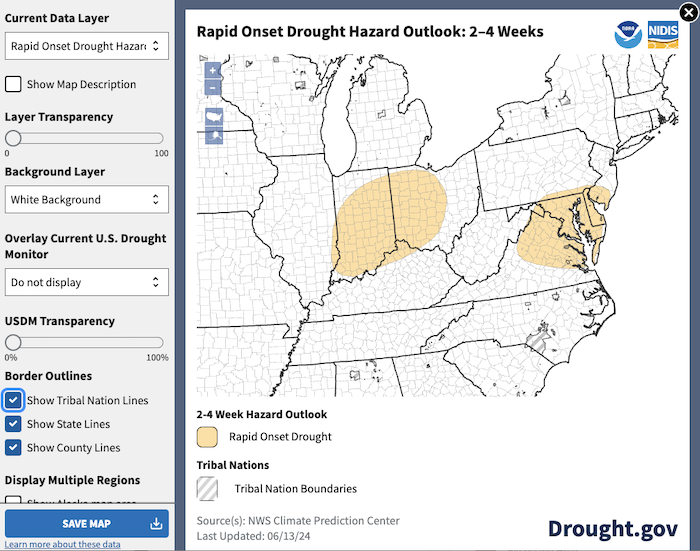New Rapid Onset Drought Tool Forecasts Flash Drought Development
Flash droughts—the rapid onset or intensification of drought—can have widespread impacts on communities, ecosystems, and the economy. However, they also have unique challenges for monitoring and prediction. NOAA’s National Weather Service (NWS) Climate Prediction Center (CPC) created the Rapid Onset Drought (ROD) hazard outlook to better predict areas at risk for flash drought development.
Challenges in monitoring & predicting flash drought

Unlike slow-evolving drought, where below-normal precipitation is often the major driver, flash drought intensification is more likely when low precipitation is accompanied by weather extremes such as high temperatures, low humidity, strong winds, and/or sunny skies, which enhances evaporative demand. These rapid changes can quickly remove available water from the landscape, leading to stressed plants, reduced crop production, increased fire risk, and more. If not monitored properly, flash drought impacts may catch people off guard as more abrupt changes are different—and potentially more damaging—than those that people have more time to prepare for.
Because of this, flash drought requires unique approaches for effective monitoring and prediction. Many existing operational drought outlooks are either not issued frequently enough or at high enough resolution for effective flash drought prediction, or lack variables relevant to flash drought (such as evapotranspiration and soil moisture). While there have been recent efforts to improve flash drought early warning, researchers and practitioners identified the need for better flash drought prediction at multiple timescales, including short-term prediction.
Building a new tool
In response to this need for better flash drought prediction, CPC created the Rapid Onset Drought (ROD) hazard outlook, which became operational in May 2024. This map highlights areas where rapid onset drought (i.e., flash drought) may develop in the coming 2–4 weeks.
CPC forecasters use initial conditions, such as existing dryness (e.g., soil moisture) and temperature and precipitation outlooks during the next 2 weeks to communicate the risk of rapidly developing drought. Rapid onset drought risk areas can give users, such as farmers making decisions about planting and supplemental irrigation, an early warning of the potential for hot and dry conditions.
The launch of the Rapid Onset Drought hazard outlook follows two years of extensive user engagement and product verification to improve the tool, which CPC launched experimentally in May 2022.
Since the operational launch of the product, NOAA’s National Integrated Drought Information System (NIDIS) worked with both CPC and the Drought.gov team at NOAA’s National Centers for Environmental Information (NCEI) to display the Rapid Onset Drought hazard outlook as an interactive map on Drought.gov, alongside other key drought and climate prediction maps. Users can zoom and pan to their area of interest, or click the "customize map" button in the top left corner of the map to customize the map image, including changing the basemap, adjusting layer transparency, adding state, county, and tribal boundary lines, and downloading a high-quality PNG image.

Prior to the launch, NIDIS supported CPC's efforts to increase awareness and use of this tool and gather stakeholder feedback through its networks and communications during the experimental phase.
CPC presented on the Rapid Onset Drought hazard outlook’s development during the NIDIS-hosted Virtual Flash Drought Workshop in 2020. In November 2022, NIDIS and CPC co-hosted a webinar that provided an overview of the tools and indicators that CPC forecasters use to assess rapid onset drought risk, case studies of rapid onset drought during the summer of 2022, and CPC’s next steps for improving the product. Meteorologists, researchers, and end users were encouraged to share their questions and experience using this new product in drought monitoring and decision-making. NIDIS also partnered with NWS to raise awareness of this product among NWS staff and other key drought monitoring stakeholders during the joint 2023–2024 NWS–NIDIS Webinar Series.
Users can view rapid onset drought risk areas alongside other probabilistic and deterministic hazards, such as temperature, precipitation, wind, and flooding, in CPC’s Week 2 (Day 8–14) U.S. Hazards Outlook. This map is updated daily on Monday–Friday afternoons and is accompanied by a text summary written by CPC forecasters, describing the potential for various hazards to pose threat to life and property. Areas at risk for rapid onset drought development in the next 2–4 weeks are issued on Thursdays, with potential adjustments the following Monday, from April 1–October 31.
CPC’s Rapid Onset Drought hazard outlook is an important step toward addressing the need for more skillful flash drought prediction.
You can view the latest Rapid Onset Drought outlook on CPC’s website or on the Drought.gov Outlooks & Forecasts page or Hazard Planning & Preparedness page.



